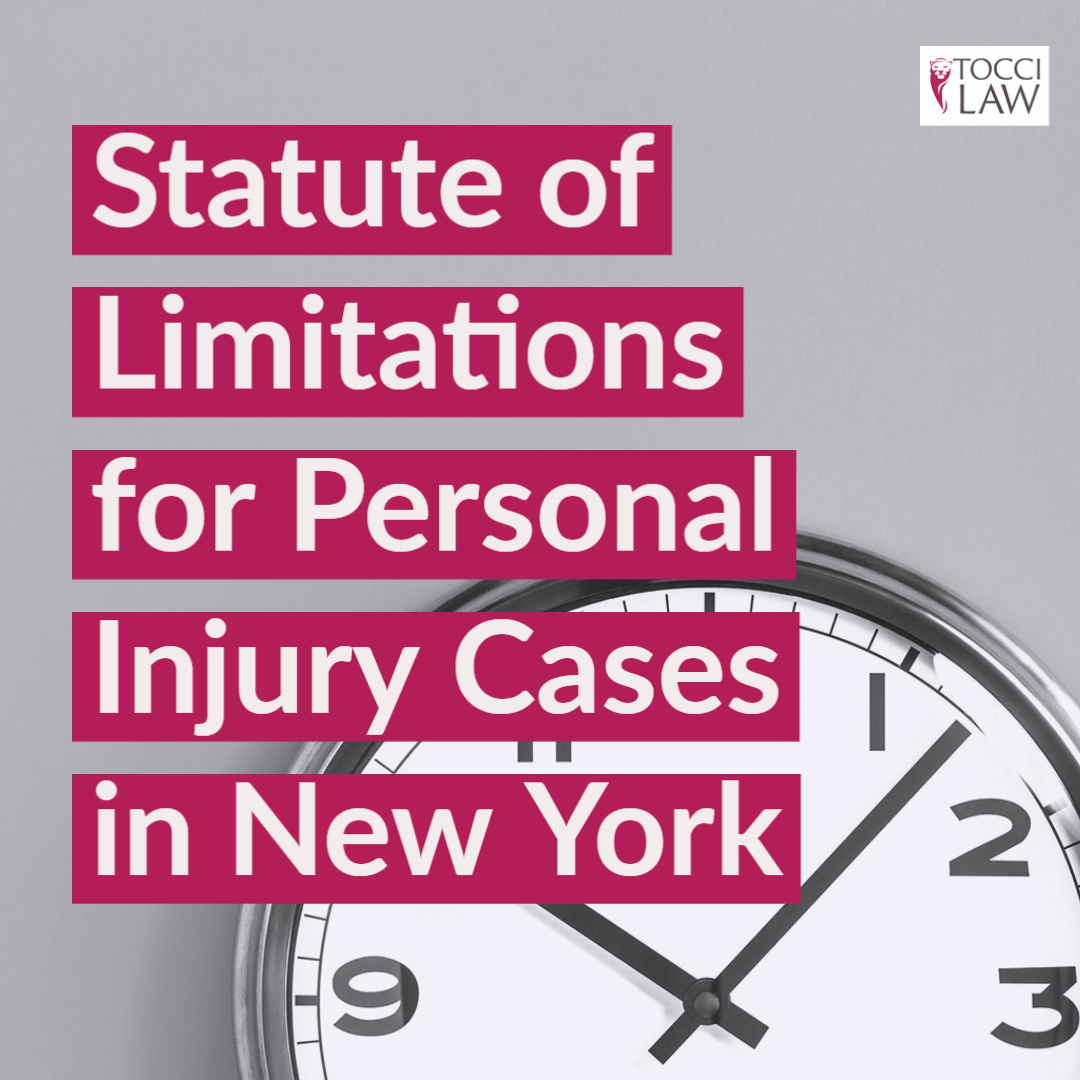Generally, in New York State, personal injury cases have a three (3) year statute of limitations. However, the statute of limitations in personal injury cases frequently deviates from this standard. Relying on the general three (3) year time frame is risky. In New York, the statute of limitations for personal injury cases depends on who you are, who the responsible party is, and the manner in which the accident occurred. All three must be taken into consideration in order to calculate the appropriate statute of limitations.
Sidebar: All information contained in this article is for general information only and should not be construed as legal advice. Seemingly insignificant details could affect the time to file suit. Speak to an attorney as soon as possible if you have been injured in an accident. When you consult with us, we analyze your specific circumstances and best courses of action for your individual situation. This information applies only to injuries sustained in New York State.
What is a statute of limitations?
A statute of limitations is the permissible time period file a lawsuit in court. Failing to file a lawsuit within the appropriate time frame can time bar the claim, leaving a potential plaintiff (party who starts a lawsuit) without a legal remedy. As a result, calculating which statute of limitations applies to each case is crucial. Furthermore, determining the date that the statute of limitations begins to run is equally important to compute the correct deadline. While the statute of limitations begins to run from the date of accident or incident in the majority of instances, this is not always the case.
How the accident occurred affects the time limits of each case:
Negligence:
If the accident occurred because of the negligence of another party, the statute of limitations is three (3) years in New York State. Negligence cases include motor vehicle accidents, slip/trip and falls and dog bites. Lawsuit documents must be filed with the court within three (3) years from the date of the accident. For example, the date a motor vehicle accident occurs starts the clock for the time to file. This is true even where an injured party does not realize they are seriously injured until a later date. Personal injuries caused by negligence are almost always governed by a three (3) year statute of limitations.
Intentional tort:
This is a fancy term meaning that someone injured another on purpose. Examples of cases involving intentional torts are assaults, gun violence, false imprisonment, defamation, and intentional infliction of emotional distress. In these cases, there is one (1) year from the date of the incident to file a lawsuit. If the perpetrator who caused the injuries is arrested for such acts, there is at least one (1) year from the date of the disposition (date of the plea or jury verdict) of the criminal case to file a case against them for injuries. Certain criminal actions, such as arson or Class A felonies, typically accompany a longer statute of limitations. It can be tricky to determine which statute of limitations applies to criminal actions, so it is important to have an attorney review the case. There is a delicate balance in cases involving intentional acts because there could be other parties who are also liable for the injuries, who are governed by separate time limits. It is best to have an attorney investigate this type of case as soon as practical.
Wrongful Death:
Wrongful death cases are predicated on the theory of negligence. Notwithstanding, wrongful death cases have a two (2) year statute of limitations. Although the statute is a shorter time period, the clock starts ticking in a wrongful death case from the date an executor or administrator is appointed by the Surrogate’s court. Depending on when an executor/administrator is appointed, the time could be longer or shorter than the standard three (3) year statute of limitations. This particular cause of action is regularly coupled with “conscious pain and suffering,” which is general negligence (in addition to wrongful death) and governed by the three (3) year statute of limitations, running from the date of the accident or incident.
Toxic Exposure:
Where injuries are sustained as a result of toxic exposure, while the three (3) year statute of limitations applies, it may be calculated from the date of discovery rather than the date of exposure. See, CPLR § 214. Cases involving mesothelioma by exposure to asbestos benefit from the date of discovery rule under CPLR § 214.
Those who have been injured by any of the above manners are not limited to claiming only one of these theories of liability. Certain accidents and injuries could theoretically fall under each of the above categories (or others). In litigation, they are called “causes of action.” The law allows injured parties to plead multiple, even conflicting, causes of action. (i.e. negligence and intentional torts may be alleged in a lawsuit at the same time for the same acts.) When multiple causes of action are plead, the injured party does not get the benefit of the later statute of limitations. To be successful in a lawsuit alleging the defendant (party being sued) was negligent, and acted intentionally, and caused wrongful death, the case would have to be filed within the shortest statute of limitations.
Who the person/party your claim is against affects the statute of limitations:
Doctors and Hospitals:
Medical malpractice (read: negligence) cases and many cases against hospitals have a 2 year and 6 month statute of limitations. Under normal circumstances, this is computed from the date of the malpractice, but there are exceptions for cases where there is continuous treatment. This time limit does not apply to everyone universally, see below for how the identity of the injured party affects the time restraints on a lawsuit.
Employers:
Injuries that happen while at work are unique in that the Workers Compensation Laws protect employers from personal injury lawsuits. In certain cases, there are exceptions to the Workers Compensation Laws. Workers’ Compensation claims may have two (2) years to file a claim. In addition, where a case may be started against a third-party who may be responsible for those injuries, under normal circumstances, there is a three (3) year statute of limitations.
Municipality:
Identifying whether a municipality (or governmental agency) was involved causing injuries can be challenging and should be evaluated by an attorney. When a case is against a municipality, there is a critically short period of time of ninety (90) days where a Notice of Claim needs to be filed and served. If a proper Notice of Claim is not filed, the claim could be forfeited. Applications may be made to the courts for leave (permission) to file a late Notice of Claim. However, this must be done within the one (1) year and ninety (90) day statute of limitations for claims against governmental entities. Failure to file a Notice of Claim or apply for an extension to file a late Notice of Claim is a fatal error in a potential lawsuit. This strict and limited time frame applies even to minors. Once a proper and timely Notice of Claim is filed, under most circumstances, a personal injury claim must be filed with the court within one (1) year and ninety (90) days. Examples of entities that may be ran by the government are police departments, parks and beaches, school districts, buildings, highway departments, jails/prisons etc.
Who is injured affects the statute of limitations:
Minors:
In most cases, but not all, minors (or infants) have an extended statute of limitations for personal injury claims. In no event will a minor have a shorter statute of limitations than an adult. However, not all statutes of limitations are extended the same length of time. Without other factors, a minor usually has until three (3) years after his or her eighteenth (18) birthday to file a lawsuit for personal injuries in New York. Instead of evaluating a minor’s case with the time starting from the date of the accident or injury, it is evaluated as beginning to run from their eighteenth (18) birthday.
Relying on this information without an attorney may be problematic because in other cases, such as cases involving medical malpractice, the minor must file their lawsuit within ten (10) years of the date of the malpractice. This holds true even where the minor is still a child and dependent upon parents or guardians to handle the matter on their behalf.
Minors are strictly bound by the ninety (90) day Notice of Claim deadline. Similar to adults, if they miss the deadline to file the Notice of Claim within the ninety (90) day time frame, they may make an application to the court for an extension of time to serve, so long as this is done within the one (1) year and ninety (90) day deadline. Unlike an adult, a minor has three (3) years from their eighteenth (18) birthday to file a lawsuit against a municipality, but only if their rights were preserved by timely filing a Notice of Claim.
Those who are incapacitated:
The statute of limitations for an individual who is legally (determined by a judge) incapacitated for a personal injury claim is three (3) years from the date the incapacity ends or the incapacitated individual dies, whichever is earlier. In any event, the statute of limitations does not extend more than ten (10) years after the cause of action accrues (i.e. date of accident/incident). However, this not always case and those who are incapacitated are still bound by the ninety (90) day time limit to file a Notice of Claim in actions against a municipality.
Have an attorney review your case:
Calculating the statute of limitations may not be straightforward and simple in every case. There are many factors that influence the statute of limitations, and it is best to have your individual case evaluated by an attorney. This legal article should not be construed as legal advice in any capacity, and we make no assertions as to the statute of limitations that may apply to any specific case. If you wish to have your specific circumstances reviewed by an attorney, schedule a private, confidential consultation with our office.
Tocci Law
(631) 343-7676










